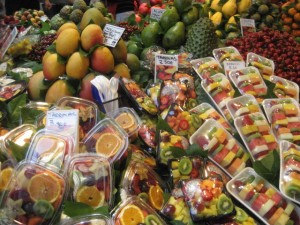MyPyramid R.I.P.
On May 26, the USDA announced that it will be releasing a new “food icon” to replace the foodless and useless 2005 MyPyramid:
The USDA’s press announcement explained:
The 2010 White House Child Obesity Task Force called for simple, actionable advice to equip consumers with information to help them make healthy food choices. As a result, USDA will be introducing the new food icon to replace the MyPyramid image as the government’s primary food group symbol. It will be an easy-to-understand visual cue to help consumers adopt healthy eating habits consistent with the 2010 Dietary Guidelines for Americans.
What will the new icon look like? The USDA isn’t saying, but William Neuman of the New York Times did some sleuthing. According to his account:
The circular plate, which will be unveiled Thursday, is meant to give consumers a fast, easily grasped reminder of the basics of a healthy diet. It consists of four colored sections, for fruits, vegetables, grains and protein, according to several people who have been briefed on the change. Beside the plate is a smaller circle for dairy, suggesting a glass of low-fat milk or perhaps a yogurt cup.
And WebMD scored an interview with Robert C. Post, PhD, deputy director of the USDA Center for Nutrition Policy and Promotion, who gave additional hints:
“There will be a ‘how-to’ that will resonate with individuals. That is the behavioral part that is needed. We need to transcend information — ‘here’s what the science says’ — and give people the tools and the opportunities to take action.”
He referred to six how-to messages to guide healthy eating that were released with the 2010 Dietary Guidelines, and which I enthusiastically posted when the Guidelines were released (I was disappointed that they weren’t actually part of the Guidelines):
Balancing Calories
• Enjoy your food, but eat less.
• Avoid oversized portions.
Foods to Increase
• Make half your plate fruits and vegetables.
• Switch to fat-free or low-fat (1%) milk.
Foods to Reduce
• Compare sodium in foods like soup, bread, and frozen meals—and choose the foods with lower numbers.
• Drink water instead of sugary drinks.
A bit of history:
From 1958 until 1979, the USDA’s food guide was sort of a rectangle illustrating four food groups: Dairy, meat, fruits and vegetables, breads and cereals. In 1979, USDA introduced a highly controversial design with food groups stacked on top of each other, with the plant-food groups at the top and the animal-food groups underneath (the producers of these foods did not like that).
Beginning in 1980, the USDA conducted an extensive research project to develop a new design—the pyramid—which it released in 1991 and withdrew immediately under pressure from meat producers.
In 1992, after a year of extraordinary controversy (recounted in my book Food Politics), the USDA released its highly controversial Food Guide Pyramid.
Why was it controversial? The food industry objected that the Pyramid make it look as if you were supposed to eat more foods from the bottom of the pyramid than the top (which, of course, was its point).
Nutritionists objected that it encouraged eating too many servings of grains and, therefore, encouraged obesity.
In 2005, the USDA replaced it with the unobjectionable MyPyramid. The food industry liked this one because it did not indicate hierarchies in food choices. Most nutritionists that I know hardly knew what to do with it. It required going online and playing with a website, and was unteachable in clinic settings.
I thought the 1992 pyramid had a lot going for it, particularly the idea that it’s better to eat some foods than others. But MyPyramid was a travesty–hopelessly complicated, impossible to teach, and requiring the use of a computer.
Given this situation, the new image is highly likely to be an improvement. If the new icon keeps the hierarchy, conveys concepts easily, and does not require online access, I will consider it a great step forward.
Fingers crossed.
Details about the release:
The announcement will be Thursday, June 2, 10:30 a.m. EDT. It will be live-streamed at www.usda.gov/live. All information will be posted at www.cnpp.usda.gov.
I’ll be there. Stay tuned.
• Avoid oversized portions.
Foods to Increase
• Make half your plate fruits and vegetables.
• Switch to fat-free or low-fat (1%) milk.
Foods to Reduce
• Compare sodium in foods like soup, bread, and frozen meals—and choose the foods with lower numbers.
• Drink water instead of sugary drinks.




